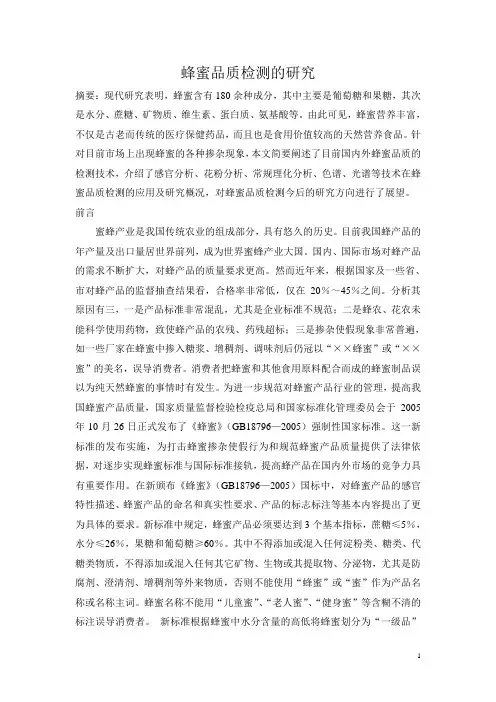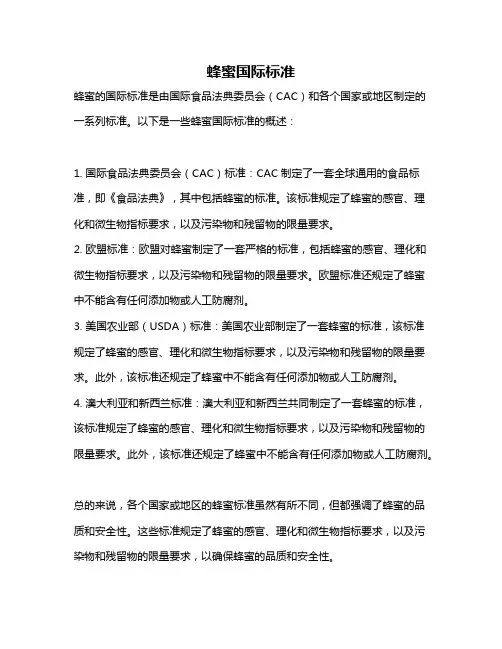WellbeingGuard 对于全球蜜蜂现状及新西兰蜂蜜趋势分析
- 格式:pdf
- 大小:658.51 KB
- 文档页数:8


全球蜂群损失问题及可持续解决方案探讨全球蜂群损失问题及可持续解决方案探讨引言:全球的蜂群数量在过去几十年一直在不断减少,这是一个极其严重的问题。
蜂群对于人类的生存和生态系统的稳定都起着至关重要的作用。
蜜蜂是植物传粉的主要载体之一,对于农业和自然生态的维持都非常重要。
然而,在过去的几十年里,蜂群数量的不断减少引发了全球关切。
本文将探讨全球蜂群损失问题的原因以及可持续解决方案,以期为解决这一问题提供有效的指导和启示。
一、全球蜂群损失的原因1. 杀虫剂的使用:农业中大量使用的农药对蜜蜂产生了极大的负面影响。
农药中的某些成分对蜜蜂有毒性,会导致蜜蜂的死亡。
经济利益驱使农业生产者使用更多更强效的农药,从而造成了蜜蜂数量的快速下降。
2. 食物源缺乏:大规模的农业生产导致了草地的减少以及单一农作物的大规模种植。
这导致了蜂群的食物源变得单一且有限,无法提供充足的养分给蜜蜂。
缺乏多样化的食物来源导致蜜蜂免疫力下降,易受到疾病和虫害的攻击。
3. 疾病与虫害:蜜蜂常常受到疾病和虫害的侵袭。
寄生虫、真菌和病毒等会对蜜蜂造成伤害和感染,导致蜜蜂群体的数量迅速减少。
4. 气候变化:全球气候变暖导致了蜜蜂栖息地的改变,也对蜜蜂的生活和适应能力造成了一定的影响。
气候变化可能导致了蜜蜂的季节性错位,使其难以找到足够的食物和适宜的栖息地。
二、可持续解决方案1. 减少杀虫剂的使用:农业生产者应在种植和保护农作物的过程中减少对农药的过度使用。
培养农民对有机农业的意识和技能,以提高农作物的抗虫性,减少对农药的依赖。
2. 保护和扩大蜂群栖息地:政府和非政府组织应加大力度保护自然环境,特别是蜂群栖息地,如草地、草原和森林等。
此外,鼓励农业生产者在农田中建立野生花坛、种植花草等可提供丰富花粉和蜜源的地方。
3. 鼓励农业多样化:政府和机构可以通过奖励措施来鼓励农民在农田中适当采用多样化农作物的种植方式,以提供更多的花粉和蜜源。
同时,科学家和农业专家可以提供引导和培训,帮助农民实施农业多样化。

土耳其养蜂实验报告土耳其养蜂实验报告引言:蜜蜂是自然界中非常重要的昆虫,它们在生态系统中扮演着关键的角色。
土耳其是一个拥有丰富自然资源和多样化生态系统的国家,因此养蜂在该国具有重要的意义。
本实验旨在研究土耳其养蜂的现状、挑战和机遇。
一、土耳其养蜂的现状土耳其拥有丰富的花卉资源和适宜的气候条件,使得养蜂业成为该国农业领域的重要组成部分。
根据统计数据,土耳其是全球最大的蜂蜜出口国之一。
土耳其蜂农通过养蜂获得了可观的经济收益,并且养蜂业在农村地区创造了大量就业机会。
然而,土耳其养蜂业也面临一些挑战。
首先,由于气候变化和环境污染等因素的影响,蜜蜂的生存环境受到了威胁。
其次,蜂农在养蜂过程中面临着技术和管理方面的困难,限制了养蜂业的发展。
此外,土耳其养蜂业还面临着市场竞争和产品质量问题。
二、土耳其养蜂的挑战1. 环境问题:气候变化和环境污染对蜜蜂的生存环境造成了威胁。
全球气候变暖导致花期变化,蜜源减少,给蜜蜂的生存带来困难。
此外,农药和其他化学物质的使用也对蜜蜂的健康产生了负面影响。
2. 技术和管理问题:蜂农在养蜂过程中面临着技术和管理方面的困难。
许多蜂农缺乏养蜂技术的培训和指导,导致蜜蜂的养殖效率低下。
此外,蜂农在蜂箱管理、疾病防控等方面也存在一定的困难。
3. 市场竞争和产品质量问题:随着全球养蜂业的发展,土耳其蜂农面临着来自其他国家的竞争。
一些国家的蜜蜂产品质量较高,价格较低,给土耳其的蜂农带来了市场压力。
土耳其蜂农需要提高产品质量,增加附加值,以提升竞争力。
三、土耳其养蜂的机遇尽管土耳其养蜂业面临一些挑战,但也存在着一些机遇。
首先,土耳其拥有丰富的花卉资源和多样化的气候条件,为养蜂提供了良好的基础。
其次,土耳其养蜂业在国内外市场上享有良好的声誉,土耳其蜂蜜的品质备受认可。
此外,土耳其蜂农可以通过技术创新和管理改进来提高养蜂效率和产品质量,以应对市场竞争。
四、土耳其养蜂的发展策略为了促进土耳其养蜂业的可持续发展,以下是一些建议的发展策略:1. 加强技术培训和指导:政府和相关机构应加大对蜂农的技术培训和指导力度,提高蜂农的养蜂技术水平和管理能力。

蜂蜜品质检测的研究摘要:现代研究表明,蜂蜜含有180余种成分,其中主要是葡萄糖和果糖,其次是水分、蔗糖、矿物质、维生素、蛋白质、氨基酸等。
由此可见,蜂蜜营养丰富,不仅是古老而传统的医疗保健药品,而且也是食用价值较高的天然营养食品。
针对目前市场上出现蜂蜜的各种掺杂现象,本文简要阐述了目前国内外蜂蜜品质的检测技术,介绍了感官分析、花粉分析、常规理化分析、色谱、光谱等技术在蜂蜜品质检测的应用及研究概况,对蜂蜜品质检测今后的研究方向进行了展望。
前言蜜蜂产业是我国传统农业的组成部分,具有悠久的历史。
目前我国蜂产品的年产量及出口量居世界前列,成为世界蜜蜂产业大国。
国内、国际市场对蜂产品的需求不断扩大,对蜂产品的质量要求更高。
然而近年来,根据国家及一些省、市对蜂产品的监督抽查结果看,合格率非常低,仅在20%~45%之间。
分析其原因有三,一是产品标准非常混乱,尤其是企业标准不规范;二是蜂农、花农未能科学使用药物,致使蜂产品的农残、药残超标;三是掺杂使假现象非常普遍,如一些厂家在蜂蜜中掺入糖浆、增稠剂、调味剂后仍冠以“××蜂蜜”或“××蜜”的美名,误导消费者。
消费者把蜂蜜和其他食用原料配合而成的蜂蜜制品误以为纯天然蜂蜜的事情时有发生。
为进一步规范对蜂蜜产品行业的管理,提高我国蜂蜜产品质量,国家质量监督检验检疫总局和国家标准化管理委员会于2005年10月26日正式发布了《蜂蜜》(GB18796—2005)强制性国家标准。
这一新标准的发布实施,为打击蜂蜜掺杂使假行为和规范蜂蜜产品质量提供了法律依据,对逐步实现蜂蜜标准与国际标准接轨,提高蜂产品在国内外市场的竞争力具有重要作用。
在新颁布《蜂蜜》(GB18796—2005)国标中,对蜂蜜产品的感官特性描述、蜂蜜产品的命名和真实性要求、产品的标志标注等基本内容提出了更为具体的要求。
新标准中规定,蜂蜜产品必须要达到3个基本指标,蔗糖≤5%,水分≤26%,果糖和葡萄糖≥60%。

概述:新西兰蜂蜜是全世界知名度最高的蜂产品品牌之一。
在新西兰的四大蜂产品企业中,蜂蜜拥有最丰富的产品线和最广阔的出口市场。
该蜂蜜从新西兰广阔多样的北岛东海岸和地势较低的南岛各处田园采集而来,具有纯天然的独有特点,是最纯净的纯天然蜂蜜。
正文:目录1、ANG奥兰塔蜂蜜品牌历史溯源2、ANG奥兰塔蜂蜜产地优势3、ANG奥兰塔蜂蜜-活性抗菌,新西兰国宝4、我们的特色产品5、最佳储存方法6、品牌全球拓展1、ANG奥兰塔蜂蜜品牌历史新西兰(New Zealand)被誉为“世界上最后一块适宜人类居住的天然净土”,位于太平洋西南部,由南北两个岛组成,以畜牧业、林木种植与加工,新西兰属温带海洋性气候,季节与北半球相反。
ANG奥兰塔蜂蜜生产商Vita Vida蜂蜜公司创立于1912,是一个家族企业,Vita Vida蜂蜜公司现在做为新西兰四大蜂产品企业,在整个新西兰拥有25,000个蜂房。
从提取优质的新西兰蜂蜜、灌装到新西兰园艺产业的专业授粉,整个过程中Vita Vida蜂蜜公司都致力于提高饲养蜜蜂的卫生条件,并为员工创造愉快的工作环境。
2、ANG奥兰塔蜂蜜产地优势ANG奥兰塔蜂蜜本土进行蜂蜜采集,储存,检测,完成无菌灌装,这保证了跨越南北半球的消费者都能品尝到同一种味道和品质。
Vita Vida现有两个经营区域——位于怀奥塔普的罗托鲁瓦工业区和北哈夫洛克的霍克湾工业区。
罗托鲁瓦工业区是集蜜蜂出口、灌装、蜂后养殖、蜂蜜包装以及向普伦蒂湾地区园艺产业提供授粉等各项工作为一体的专业区域。
霍克湾工业区负责蜂蜜的包装和贴牌以及为霍克湾地区的园艺产业提供授粉服务。
从蜂场提取蜂蜜到蜂蜜灌装的每一道工序,新西兰政府都对蜂蜜中含有农残、重金属、抗生素、氯霉素等有害物质进行严格把关,蜂蜜品质远远高于其他西方发达国家。
就连德国——这个蜂蜜生产以及蜂蜜人均消费大国的消费者也将购买新西兰蜂蜜为美食首选。
3、ANG奥兰塔蜂蜜-活性抗菌,新西兰国宝新西兰土著居民毛利人早在几个世纪前就已经发现麦卢卡树是一种神奇的“药用植物”,常被用于治疗各种伤口和感染、皮肤溃疡、湿疹等。

蜜蜂对气候变化的适应性与生态风险分析气候变化是目前全球面临的重大问题之一,它正在对物种的适应性和生存环境产生深远的影响。
作为重要的传粉媒介和蜜制品生产者,蜜蜂的生存状况对世界农业和生态系统的健康起着至关重要的作用。
本文将从蜜蜂对气候变化的适应性和生态风险两方面进行探讨。
一、蜜蜂对气候变化的适应性气候变化导致气温升高、降雨模式改变和自然灾害频繁等影响,这些变化都会对蜜蜂的生存和繁殖带来影响。
但是,蜜蜂有一定的适应性,针对气候变化的这些影响,它们也在不断地适应和调整。
1.生物钟调整蜜蜂的生命活动受到环境变化的影响,它们会通过调整生物钟来适应气候变化。
研究表明,当蜜蜂面临困难时,会产生更多的蜜蜂皇后素,同时这也会刺激蜜蜂生物钟的改变,以适应环境变化。
2.改变采集范围蜜蜂采集食物的范围也会受到气候变化的影响。
为了适应环境,蜜蜂可能会扩大采集范围或者改变食物的种类。
如在气候干旱的地区,蜜蜂会采集不同的花种来应对干旱的情况。
3.群体调整蜜蜂的行为受到不同因素的影响,例如温度、湿度、光线等等,这些因素会影响蜜蜂的飞舞和舞蹈,从而影响蜜蜂群体的运作。
在气候变化的情况下,蜜蜂社会可能会出现问题,这时候就需要群体调整,以维持正常的生产和传粉工作。
二、蜜蜂的生态风险分析气候变化的同时,人类的生态环境也在不断地受到威胁,而蜜蜂的生态风险也随之增加。
下面将从生态环境和人类活动两个方面进行分析。
1.生态环境人类对自然环境的破坏对蜜蜂的生存造成了威胁。
过度的城市化和农业生产导致了蜜蜂的栖息地的破坏,这使得蜜蜂的生存面临威胁。
除此之外,采用化学农药和除草剂等化学物质会对蜜蜂产生致命的影响。
2.人类活动人类活动也在对蜜蜂的生态环境造成影响。
随着城市化的加速,许多城市都在禁止养蜂,同时人类的习惯也在逐渐改变,越来越少的人喜欢吃蜂蜜和蜜蜂产品,这些都对蜜蜂的存在造成了威胁。
同时,许多野生蜜蜂种群也因为人类过度开采而降低了数量,对生态环境造成了负面影响。

蜂蜜国际标准
蜂蜜的国际标准是由国际食品法典委员会(CAC)和各个国家或地区制定的一系列标准。
以下是一些蜂蜜国际标准的概述:
1. 国际食品法典委员会(CAC)标准:CAC制定了一套全球通用的食品标准,即《食品法典》,其中包括蜂蜜的标准。
该标准规定了蜂蜜的感官、理化和微生物指标要求,以及污染物和残留物的限量要求。
2. 欧盟标准:欧盟对蜂蜜制定了一套严格的标准,包括蜂蜜的感官、理化和微生物指标要求,以及污染物和残留物的限量要求。
欧盟标准还规定了蜂蜜中不能含有任何添加物或人工防腐剂。
3. 美国农业部(USDA)标准:美国农业部制定了一套蜂蜜的标准,该标准规定了蜂蜜的感官、理化和微生物指标要求,以及污染物和残留物的限量要求。
此外,该标准还规定了蜂蜜中不能含有任何添加物或人工防腐剂。
4. 澳大利亚和新西兰标准:澳大利亚和新西兰共同制定了一套蜂蜜的标准,该标准规定了蜂蜜的感官、理化和微生物指标要求,以及污染物和残留物的限量要求。
此外,该标准还规定了蜂蜜中不能含有任何添加物或人工防腐剂。
总的来说,各个国家或地区的蜂蜜标准虽然有所不同,但都强调了蜂蜜的品质和安全性。
这些标准规定了蜂蜜的感官、理化和微生物指标要求,以及污染物和残留物的限量要求,以确保蜂蜜的品质和安全性。

2024年安赛蜜市场分析现状引言安赛蜜市场是指安赛蜜产品在市场上的销售和竞争情况。
安赛蜜以其独特的口感和营养价值在市场上备受瞩目。
本文将对安赛蜜市场的现状进行分析,以便更好地了解市场趋势和潜在机会。
市场规模安赛蜜市场是一个快速增长的市场。
根据市场调研数据,过去几年安赛蜜市场的规模呈现出稳定增长的趋势。
消费者对营养健康和高品质食品的追求,推动了安赛蜜市场的发展。
预计未来几年内市场规模将继续扩大。
市场竞争安赛蜜市场存在着激烈的竞争。
目前市场上存在多个安赛蜜品牌,它们通过品质、包装、价格等方面进行差异化竞争。
同时,传统蜂蜜产品也成为安赛蜜市场的竞争对手。
安赛蜜品牌需要通过产品创新和营销策略来提升竞争力。
消费者需求安赛蜜市场的消费者需求主要体现在以下几个方面:1.健康饮食:消费者越来越注重健康饮食,对于高营养价值的食品有较高的需求。
2.天然有机:消费者对天然有机的食品有偏爱,安赛蜜的天然特性符合了他们的需求。
3.口感体验:安赛蜜的独特口感受到了消费者的喜爱,他们追求舌尖上的享受。
安赛蜜品牌可以通过满足消费者的需求来吸引更多的消费者和提升市场份额。
销售渠道安赛蜜的销售渠道主要包括以下几种:1.线上渠道:通过电商平台销售是目前安赛蜜品牌的主要销售渠道之一。
线上渠道具有较低的销售成本和广阔的销售范围。
2.线下渠道:超市、便利店、专卖店是消费者购买安赛蜜的常见线下渠道。
线下渠道具有便捷性和实体店的产品展示优势。
3.出口渠道:安赛蜜的出口市场也是一个重要的销售渠道,通过开拓国际市场可以进一步提升销量和品牌影响力。
市场趋势从市场发展的角度来看,安赛蜜市场有以下几个趋势:1.产品创新:安赛蜜品牌需要不断进行产品创新,开发出更多口味、更高营养价值的产品,以满足消费者的多样化需求。
2.区域市场拓展:安赛蜜市场在国内已经发展良好,接下来的趋势是向国际市场拓展,特别是亚洲和欧洲市场。
3.品牌营销:品牌建设和营销活动对于提升市场份额至关重要。

新疆养蜂产业发展情况汇报
近年来,新疆养蜂产业取得了长足的发展,成为当地农业经济的重要支柱之一。
养蜂产业在新疆的发展情况备受关注,以下将就新疆养蜂产业的现状、发展趋势和存在的问题进行汇报。
首先,新疆地处干旱、少雨的气候条件下,适宜蜜蜂生存繁衍。
新疆拥有广阔
的草原和丰富的植物资源,为蜜蜂提供了良好的生存环境。
同时,新疆独特的地理位置和气候条件,使得新疆的蜂蜜味道独特,品质优良,深受市场欢迎。
其次,新疆养蜂产业在政策支持下蓬勃发展。
政府加大了对养蜂产业的扶持力度,出台了一系列扶持政策,包括财政补贴、技术培训、市场开拓等方面的支持,为养蜂产业的发展提供了有力保障。
再次,新疆养蜂产业的市场需求持续增长。
随着人们生活水平的提高和对健康
的追求,蜂蜜等蜂产品的消费需求逐渐增加。
同时,新疆养蜂产业也在不断拓展产品的深加工,开发蜂蜜、蜂王浆等系列产品,满足市场多样化需求。
然而,新疆养蜂产业也面临一些问题和挑战。
首先,养蜂业者的技术水平参差
不齐,部分养蜂户缺乏科学养蜂知识和技能,导致产量和质量无法保障。
其次,市场竞争激烈,一些小型养蜂户面临销售渠道不畅、价格波动等问题。
最后,新疆养蜂产业在发展过程中也面临着生态环境保护和资源利用的挑战,需要加强可持续发展意识,避免过度开发和滥伐林木。
综上所述,新疆养蜂产业在政策扶持和市场需求的推动下,取得了长足的发展。
但同时也面临着一些问题和挑战,需要政府、企业和养蜂从业者共同努力,加强技术培训、加大科技投入,提高养蜂产业的整体素质和竞争力,推动新疆养蜂产业迈向更加健康、可持续的发展道路。

调研蜜蜂报告蜜蜂是一种社会性昆虫,常见于世界各地的自然环境中。
它们以其辛勤努力和高效的工作方式而闻名,在人类生活和自然生态中起着重要的作用。
为了进一步了解蜜蜂的特点和重要性,我对蜜蜂进行了一次调研。
以下是关于蜜蜂的调研报告。
首先,蜜蜂的生活方式主要是社会性群体生活。
每个蜜蜂群体由一只女王蜂、工蜂和雄蜂构成。
女王蜂是整个蜜蜂群的核心,负责繁殖后代。
工蜂则负责收集花蜜、采集花粉和建立蜂巢,以供群体存放蜜和孵化幼蜂。
雄蜂的功能在于与女王蜂交配来进行繁殖。
其次,蜜蜂对自然生态和人类生活具有重要的意义。
蜜蜂的主要任务是授粉,通过飞行和触及花朵来传播花粉。
在授粉过程中,蜜蜂不仅帮助植物繁殖,还促进了植物种群的遗传多样性。
此外,蜜蜂是许多农作物的重要传粉者,如苹果、梨、草莓等,对农业的发展和粮食生产具有重要的推动作用。
然而,蜜蜂面临一些严峻的挑战。
调研中发现,蜜蜂受到了全球变暖、气候变化和农药的威胁。
全球变暖导致花期的变化,而蜜蜂和植物的生命周期密切相关,这可能会对蜜蜂的食物和栖息地产生负面影响。
此外,农药的广泛使用可能对蜜蜂造成毒害,破坏它们的神经系统和导航能力。
针对这些问题,一些保护蜜蜂的措施已经被提出。
首先,减少农药的使用对蜜蜂的生存至关重要。
采用有机农业和生物防控方法可以降低农药残留,保护蜜蜂和其他有益昆虫的健康。
其次,为蜜蜂提供丰富多样的花卉资源和适宜的栖息地,以确保它们有足够的食物和生活空间。
此外,加强对蜜蜂的科学研究和监测,以及教育公众了解蜜蜂的重要性也是必要的。
结论上述,蜜蜂作为社会性昆虫,在生物多样性维护、农业生产和环境保护等方面扮演着重要角色。
然而,由于全球变暖和农药的威胁,蜜蜂正面临巨大的挑战。
通过减少农药使用、提供丰富的花卉资源和适宜的栖息地,以及加强科学研究和公众教育,可以为蜜蜂的保护和可持续发展做出贡献。
我们应该意识到蜜蜂的重要性,并共同努力保护它们,以确保我们的生态系统的健康和生态平衡。

北京百花蜂蜜企业swot分析
SWOT分析是一个企业常用的工具,可以帮助企业了解自身的优劣势以及机会和威胁。以下
是北京百花蜂蜜企业SWOT分析:
优势:
1. 产品品质优良,品牌口碑良好
2. 产品涵盖多个品类,满足不同消费者需求
3. 技术研发实力雄厚,不断推出新品
4. 具有一定的市场占有率
劣势:
1. 产品价格相对较高,面对价格敏感消费者的市场份额受限
2. 产品市场覆盖面较小,市场拓展有限
3. 销售渠道单一,缺乏多元化销售渠道的支持
机会:
1. 蜂产品消费市场需求稳步增长,未来发展潜力巨大
2. 政策环境逐渐明朗,政府支持力度加大
3. 加强线上推广和电商销售,拓展市场覆盖面
威胁:
1. 同行业厂商竞争激烈,市场份额逐渐受到挤压
2. 消费者健康意识的不断提高,对产品质量和安全要求更高
3. 原材料价格波动导致生产成本上升,对企业盈利带来影响
基于以上SWOT分析,北京百花蜂蜜企业应该把握市场机会,加强技术研发、多元化销售
渠道布局,提升产品品质和品牌影响力,降低成本,从而在激烈的竞争中占据一席之地。
2021年第6期蜜蜂杂志(月刊)J O U R N A L O F B E E(M o n th ly)15•係程於文固他或析f唪援粉与绿笆防控集成发展责景秦子懿^胡福良2(1.浙江大学传媒与国际文化学院新闻学1901班,浙江杭州310058;2.浙江大学动物科学学院,浙江杭州310058)摘要:蜜蜂授粉在农作物的生产过程中起着不 可或缺的作用,然而我国蜜蜂授粉前期普及应用中产 生了诸多问题。
随着绿色防控技术集成的发展,蜜蜂 授粉中的诸多难题迎刃而解,蜜蜂授粉促进农业提质 增效的作用更加显著。
立足于我国蜜蜂授粉的发展现 状,对相关文献的研究结果进行梳理,并对在与绿色 防控技术集成发展条件下的蜜蜂授粉的效益与前景等 方面进行简要分析与探讨。
关键词:蜜蜂授粉;绿色防控技术;人工激素授粉 中图分类号:S89 文献标识码:A文章编号:1003-9139 (2021) 06-0015-041引言我国的蜂产业规模在世界上位居首位,而我国蜜蜂产业中蜂农的主要收人依靠于销售各种蜂产品|1],对于蜜蜂的“月下老人”授粉这一服务性功能并没有得到很好地重视,其相关的商业、生态价值也没有得到充分的挖掘。
然 而多项实验研究表明,蜜蜂授粉对于提高农作物产量、品质均有显著作用p],经济效益与生态效益不可忽视,因此,蜜蜂授粉是大多数农作物生产过程中不可或缺的环节。
美国、澳大利亚等蜂产业发达的国家对于蜜蜂授粉的推广应用相对成熟,虽然我国蜜蜂授粉的研究起步晚,但近年来从学术界对于蜜蜂授粉相关的理论实践研究,到政府出台文件,支持开展蜜蜂授粉技术研发与示范推广工作,蜜蜂授粉展现了其广阔发展空间。
尤其是随着绿色防控技术发展与生态农业可持续发展理念的贯彻,蜜蜂授粉必将是未来授粉市场的发展方向,蜜蜂授粉在与绿色防控技术集成中也展现了巨大的潜在市场需求。
2蜜蜂授粉在我国的应用研究人类80%以上的食物经由蜜蜂直接或间接授粉,蜜蜂在农作物授粉期进行连续授粉,可以使作物受粉充实,坐果率高,果型周正,口感、品质上乘,经济效益、生态效益和社会效益明显%各地区蜜蜂养殖数量与农业生产中应用蜜蜂授粉的面积是衡量一个地区生态环境建设和安全生产的重要指标。
新西兰十一坊举世无双的人间仙境,位于南太平洋那片纯净原始的土地——新西兰,它如同一个微缩的地球:雪山、森林、温泉、湖泊、海洋、草原……几乎所有的地貌景观都能在这里看到。
这里是全球自然生态保持最好的国家之一,也是最负盛名的珍稀物种资源宝库和营养健康产品输出地。
在这里,大自然显得如此亲和,“珍稀自然,追寻本真”融汇了我们的宗旨、理念、使命与承诺,简单来说,它就是十一坊的品牌哲学。
原料:与大自然合作研究表明,小至皮肤衰老,大至心脑血管硬化、结石、癌症等多种疾病的发病率上升,都与环境污染密切相关,如水污染、大气污染、化学污染等。
只有一种方法可以达致健康——顺应自然。
我们相信优质的环境才能造就优质产品,新西兰的慷慨赐予,让我们可采收引以为傲的植物、动物、海洋生物等天然原料,制造纯净无污染、富含大自然营养精华的十一坊系列产品。
·臻选优质天然原料地球上任何物种都有其与生俱来的特性,最适宜的生存环境必然限定于某些特定区域,如新西兰的牧草,与杀虫剂、化肥农药等有害物几乎绝缘,为人们带来纯净无污染的乳制品、鹿制品,堪称世界之最。
除了本土原产的珍贵自然资源,我们也放眼全球寻找优质天然原料。
·采撷鲜活营养精华以植物为例,只有在特定的时节从植株特定部位提取的成分,才是有效的活性物。
如针叶樱桃应该在维C含量最高的青果期采收;库拉索芦荟生长期必需达三年以上才是最佳选择;原花青素(OPC)虽然从多种植物的皮、茎、叶、种子中都能提取,但唯有红葡萄籽中的原花青素含量、生物活性独占鳌头。
·制定精确安全标准我们坚持一套严格的“三不准则”:即原料中的功效成分“不破坏、不损失、不转化有害中间体”,并仔细分析原料的营养及活性成分、含水量、微生物、有害化学物质残留度等指标,确保投入生产的原料安全且稳定。
配方:善用自然界的生物能量我们投入大量资源用于原料应用研究及产品配方开发。
不仅对原料活性物的功效及其达到更佳效果的剂量进行研究,同时也要研究辅助原料是否会影响配方效果等细节问题。
蜜蜂养殖可行性研究报告一、引言蜜蜂养殖是一项传统的农业产业,具有重要的经济和生态价值。
本报告旨在研究蜜蜂养殖的可行性,并提供相关建议。
二、蜜蜂养殖的意义1. 经济价值蜜蜂养殖可以产出丰富的蜂蜜和蜂蜜制品,这些产品在市场上有稳定的需求,并具有较高的附加值。
养殖蜜蜂不仅可以提供农户的经济收入,还可以促进农村经济的发展。
2. 生态价值蜜蜂是重要的传粉昆虫,对农作物的生产起到不可替代的作用。
养殖蜜蜂有助于保护和改善生态环境,促进农业可持续发展。
三、蜜蜂养殖的可行性分析1. 市场需求目前,蜂蜜和蜂蜜制品市场需求量持续增长。
随着人们健康意识的提高和对天然食品的追求,蜜蜂养殖产业有良好的发展前景。
2. 技术条件蜜蜂养殖需要掌握一定的技术,包括蜜蜂的繁殖、饲养、疫病防治等方面知识。
农户需要积极学习相关知识,以提高养殖效益。
3. 资金投入蜜蜂养殖需要一定的资金投入,包括蜜蜂箱、蜂群购买、蜜蜂饲料等方面。
农户可以通过农村小额信贷、合作社等渠道获得资金支持。
4. 市场竞争蜜蜂养殖市场竞争较为激烈,要想在市场上获得竞争优势,农户需要具备一定的市场营销能力,提供高品质的蜂蜜和蜂蜜制品。
四、蜜蜂养殖的建议1. 积极学习农户应该通过各种途径积极学习蜜蜂养殖的知识和技术,包括参加培训班、阅读相关书籍和网络资料等。
掌握专业知识能够提高养殖效益和抗风险能力。
2. 建立合作社农户可以考虑组建蜜蜂养殖合作社,通过集中采购设备和原材料、共同销售产品等方式,降低成本,提高竞争力。
3. 加强市场营销农户可以积极参加农产品展销会、开设线上店铺等方式,拓宽销售渠道,提高产品知名度和市场份额。
4. 关注产品质量和安全蜜蜂养殖产品涉及食品安全和质量问题,农户应当依法合规经营,确保蜜蜂产品的质量和安全性,提高消费者的信任度。
五、结论综上所述,蜜蜂养殖具有较高的经济和生态价值,市场需求量大。
农户要充分发挥自身优势,提高技术水平,加强市场营销,提高产品质量,以获得良好的经济效益和社会效益。
关于蜂蜜的英语美文阅读蜂蜜是蜜蜂采集花朵的蜜汁或动植物有生部分的分泌物(如蚜虫),经蜜蜂利用特殊物质加工、酿制、混合并储存于蜂巢中的一种甜味物质,是一种营养丰富的天然滋补品。
下面是店铺带来的关于蜂蜜的英语美文阅读,欢迎阅读!关于蜂蜜的英语美文阅读篇一蜂蜜-历史悠久的保鲜剂Honey has been around for a very long time. Cave paintings in Spain from over ten thousand years ago show people harvesting honey. Today honey is mostly used for its distinctive flavor, but for baking it has another advantage as well: baked goods made with honey take longer to get stale.Honey helps baked goods stay fresh longer because, unlike common table sugar(蔗糖;食糖), honey is made of two so-called “simple” sugars: glucose(葡萄糖) and fructose(果糖). Table sugar also has glucose and fructose, but they’re chemically bonded together in a double sugar(【生物化学】双糖) called “sucrose(蔗糖).” Having two single sugars instead of one double sugar means that ounce-for-ounce honey contains more sugar molecules, which is why honey is also a little sweeter than table sugar.But the reason honey helps keep baked goods fresh has to do with the ability of sugar to attract and hold onto water molecules. All these sugars are “hygroscopic,” that is they attract and hold onto water, each sugar molecule holding several water molecules. By holding onto water, the sugar helps keep moisture from escaping from the food and so keeps it tasting fresher longer.But when two sugars, like fructose and glucose, bond to eachother, they lose some of their ability to bond to water molecules. And that means your bread or cake will lose water faster. Honey’s attraction to water is also why candy made from honey tends to get stickier than candy made from sucrose, or table sugar.Commercial bakeries use chemicals like Polysorbate(聚山梨醇酯) to keep baked goods fresh, but with honey you can do it natura lly. Incidentally, if you’re worried that honey will make your cake too heavy, try beating the honey until it’s frothy before adding the other ingredients.关于蜂蜜的英语美文阅读篇二关于蜂蜜水的7大益处Maybe you only know the benefits of a warm glass of water in the morning or maybe you have only heard about how honey is great for your skin, but have you heard what wonders combining warm water and honey can do for you overall? Read on and let me tell you the wonders of honey and warm water.也许你只知道每天早上一杯温开水的益处,或者也许你只听说过蜂蜜对你的皮肤有好处,但是你听说过把蜂蜜和温开水放在一起的好处吗?看看这些吧,让我来告诉你温蜂蜜水的好处吧。
WellbeingGuard 2013 WellbeingGuard 对全球蜜蜂现状及新西兰蜂蜜趋势分析
WellbeingGuard
http://weibo.com/u/3382656310 http://www.wellbeingguard.com/ 1 目录 English Version ....................................................................................................................2
The current situation of honey products ..........................................................................2 1. Bee population decreases ....................................................................................2 2. Less bee, less honey products .............................................................................2 Manuka Honey .................................................................................................................3 1. What is it? ..............................................................................................................3 2. The benefits of Manuka Honey .............................................................................3 Question ...........................................................................................................................4 Chinese Version...................................................................................................................5
蜂蜜产品现状 ....................................................................................................................5 1. 蜂蜜数量下降.............................................................................................................5 2. 少蜂,少蜂蜜产品 .....................................................................................................5 麦卢卡蜂蜜........................................................................................................................6 1. 什么是麦卢卡蜂蜜 .....................................................................................................6 2. 麦卢卡蜂蜜的好处 .....................................................................................................6 问题..................................................................................................... 错误!未定义书签。 Reference/参考文献 .............................................................................................................7
http://weibo.com/u/3382656310 http://www.wellbeingguard.com/ 2 English Version Honey brings humanbeings huge greats healthy benefits. While what would be the result, especially to Manuka Honey, when bee population in the world drops? To find the answer to this question, following report is created by WellbeingGuard.
The current situation of honey products 1. Bee population decreases Medias respectively reported that bee population in the world is at crisis. TVNZ One News is one of the channels of New Zealand’s national broadcaster (TVNZ, n.d.). TVNZ One News (2013) reported on January 13, the number of New Zealand’s wild bee has been gradually decreasing since 2000. Moreover, Gerry Hadden is an author and journalist for American’s National Public Radio (PRI's The World, n.b.). On March 27, Hadden (as sited in PRI's The World, 2013) reported that the bee population in Europe is in decrease and there is a huge decline in the queen production in Scotland. Furthermore, Metro is one of UK’s morning newspapers (Metro, n.d.). Smith (as sited in Metro, 2013) reported on Aepril 18 that beekeepers in Britain are at the “crisis point”. All these news clearly claimed that the number of bee population is in decrease.
2. Less bee, less honey products What is the influence of bee population in decrease? The prior question is how honeybees make honey. The Animal Planet (n.d.) discovers that the procedures of honey-making procedure start from visiting flowers to gather nectar. Pollen grains are transferred from one flower to another during the process of gathering nectar and then nectar works with enzyme to make honey (The Animal Planet, n.d.). According to the discovery of the Animal Planet, it concludes that less bee fly out to collect nectar results less honey. The decrease in bee population in the world causes the available less honey products.
http://weibo.com/u/3382656310 http://www.wellbeingguard.com/ 3 What is the influence of less honey products in the market? NetMBA (2010) teaches that at the same quantity demand of goods, when the quantity supply of the goods drops, shortage exists and the price of the goods increases. Based on NetMBA theory, when honey haves less quantity supply than quantity demand, there is a shortage of the honey on the market. Consequently, the price of honey increases. Less quantity supply in honey increases honey’s price.